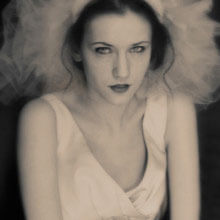Reisinger Zsuzsanna is a young Hungarian self-taught photographer who lives in Budapest.
Artist Statement
"What drives me in my photographic work as in life, is the transience, the fragility of life itself. I try to capture this in images, frozen moments in time, taken now or in the past, but all becoming history at the very moment of capture. This vision, or rather this feeling, I try to convey to the viewer mainly through my portraits of women, of femininity.
As is often the case, images can transfer my feelings and sensations better than words can. As very aptly said by Lao Tzu: The Tao that can be told... is not the real Tao...
Photography, and especially portraiture, is my kind of time travel, I enjoy immensely. During thinking of a concept, making all the arrangements, and taking the actual pictures, time stands still... Later on, all these pictures are history, of course. My work mainly is about these forgotten times and moments..."
